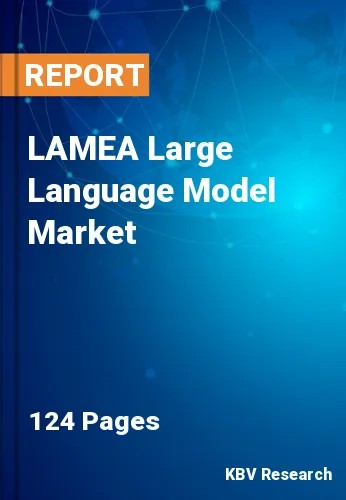The Latin America, Middle East and Africa Large Language Model Market would witness market growth of 37.1% CAGR during the forecast period (2023-2030).
Collaborative efforts among researchers, developers, and organizations are fostering cross-industry collaboration. Collaborative research initiatives, shared datasets, and open-source contributions all contribute to advancing large language models and facilitating the exchange of best practices and information. In addition, innovations in responsible AI development focus on addressing ethical concerns associated with large language models. This includes the development of algorithms and practices to reduce biases, enhance explainability, and ensure transparency in model behaviour. Acknowledging the environmental impact of large language model training, green AI initiatives are gaining traction. To mitigate the environmental impact linked to the training of large-scale models, scholars are investigating hardware and algorithms that are more sustainable and energy-efficient.
Likewise, future innovations may involve tailoring large language models for specific industries. Customized models could address domain-specific challenges, providing more accurate and contextually relevant outputs in healthcare, finance, and legal areas. Advances in user-specific adaptation may lead to more personalized user experiences. It could dynamically adjust their responses based on individual user preferences, language styles, and interaction histories, enhancing the overall user experience. Hybrid models that combine the strengths of large language models with other AI modalities, such as vision or audio, are anticipated. Cross-modal learning strategies strive to develop AI systems that are more comprehensive in nature and able to comprehend and produce content using a wide range of modalities.
Moreover, e-commerce platforms in the UAE can benefit from generating localized and culturally relevant content to connect with a diverse consumer base. It can assist in creating high-quality, context-aware content that resonates with the local audience. As per the data from the International Trade Administration, Among Gulf Cooperation Council (GCC) nations, the UAE is the leader in e-commerce, with a record-breaking $3.9 billion in e-commerce sales in 2020, representing 10% of total retail sales and a 53% increase. Hence, the growing e-commerce sector in the LAMEA region will help in the growth of the regional market.
The Brazil market dominated the LAMEA Large Language Model Market by Country in 2022, and would continue to be a dominant market till 2030; thereby, achieving a market value of $746.4 million by 2030. The Argentina market is exhibiting a CAGR of 37.8% during (2023 - 2030). Additionally, The UAE market would experience a CAGR of 36.6% during (2023 - 2030).
Free Valuable Insights: The Worldwide Large Language Model Market is Projected to reach USD 33.1 Billion by 2030, at a CAGR of 34.3%
Based on Deployment, the market is segmented into On-premise, and Cloud. Based on Vertical, the market is segmented into Retail & E-commerce, Media & Entertainment, Finance, Healthcare, and Others. Based on Application, the market is segmented into Chatbots & Virtual Assistant, Customer Service, Content Generation, Sentiment Analysis, Code Generation, and Language Translation. Based on countries, the market is segmented into Brazil, Argentina, UAE, Saudi Arabia, South Africa, Nigeria, and Rest of LAMEA.
By Deployment
By Vertical
By Application
By Country
Our team of dedicated experts can provide you with attractive expansion opportunities for your business.

